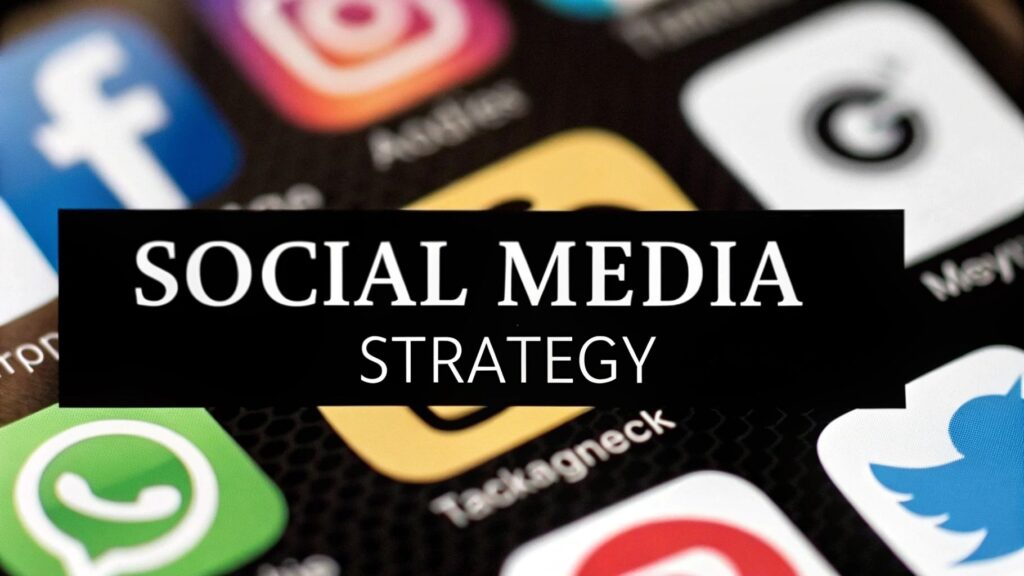
Choosing the Right Social Platforms for Maximum Impact

Success in social media isn't about being on every platform – it's about focusing your efforts where your audience spends their time. Having a strategic presence on select networks brings better results than spreading yourself too thin across many platforms. When you concentrate on the right channels, you can create content that truly connects with your target audience.
Understanding Your Target Audience
Start by getting clear on who your target audience is and where they hang out online. What content formats do they prefer? What topics interest them? What problems are they trying to solve? Let these insights guide your platform choices. For example, visual platforms like Instagram, TikTok, and Snapchat work well for reaching younger audiences, while LinkedIn is ideal for connecting with business professionals.
Evaluating Platform ROI
Focus your efforts on platforms that deliver real business results. Recent data shows that 29% of marketers get their best ROI from Facebook and Instagram. This makes sense given that 58% of high-income U.S. households use Instagram regularly. For more insights, check out DesignRush's Social Media Marketing Statistics.
Allocating Resources Effectively
Once you pick your key platforms, be smart about how you use your resources. Quality content takes significant time and effort to create. Rather than overwhelming your team by trying to be active everywhere, start with 2-3 platforms where you can excel. You can always expand to other networks as your capacity grows.
Maintaining an Authentic Presence
Being authentic across different platforms takes work, but it builds trust with your audience. Keep your brand voice consistent while adapting your content style to each platform. Think of it like adjusting how you communicate with different people while staying true to who you are. Your core message should shine through, even as you customize your delivery.
Measuring Platform-Specific Success
Track metrics that align with your goals on each platform. If you want website traffic, focus on click-through rates. For lead generation, monitor form conversions. Use these insights to understand which platforms drive real business results. This data helps you refine your strategy and invest more in what's working. Regular analysis ensures your social media efforts support your business objectives.
Mastering the Art of Social Selling

Social media marketing is about more than accumulating likes and followers. The real power lies in building real connections that drive sales and create lasting customer relationships. This approach, known as social selling, focuses on finding potential customers, developing authentic relationships, and turning social media followers into loyal buyers.
Finding Your Best Prospects
The beauty of social selling is how precisely you can target specific audiences. This targeted approach helps you focus on high-value prospects who are most likely to become loyal customers. Tools like LinkedIn Sales Navigator help identify key decision-makers, while Facebook and Instagram's ad tools let you narrow down audiences by specific traits and behaviors. This focused method ensures your message finds the right people at the perfect moment.
Building Connections Through Quality Content
The heart of social selling isn't pushing products – it's giving real value to your audience. When you share content that teaches something useful or solves a problem, you become a trusted source of information. Your brand grows stronger as you join conversations, answer questions, and respond thoughtfully to comments. These small but meaningful interactions help build a genuine community around your business.
The numbers show why social selling works so well. 87% of buyers say social media shapes their purchasing choices, while 66% of customers buy after seeing social posts from others. Social selling creates 45% more opportunities than traditional sales methods, and 78% of salespeople who use it perform better than those who don't. Learn more details at OptinMonster's social selling statistics. This relationship-focused approach often leads to customers who stick around longer and spend more.
Creating Trust That Drives Sales
Trust makes sales happen. By consistently delivering value and engaging honestly with your audience, you build the confidence needed to turn followers into buyers. When you introduce products or services, people are more likely to respond because they already see you as credible. Taking time to personalize your approach based on individual needs can significantly boost your success rate.
Making Your Social Selling More Effective
Keeping track of important numbers (KPIs) like new leads, sales, and customer value helps you understand what's working. This data shows you where to make improvements and how to get better results over time. Regular analysis helps you make smart decisions about where to focus your efforts. For more ideas, check out 5 Sure-Fire Social Media Tactics to Jump-Start Your Job Search. Following these proven social media practices helps you build meaningful customer relationships and grow your business steadily.
Making the Most of Ephemeral Content

Social media success depends on grabbing and keeping people's attention. Ephemeral content like Stories and Reels helps you do exactly that. These posts disappear after a short time, which creates a natural sense of urgency and gets people to engage quickly. Let's look at how to use this short-lived content format to boost your social media results.
The Psychology of Limited-Time Content
When content is only available for a short time, it taps into people's natural fear of missing out (FOMO). Think about how you feel when you see a "limited time offer" or "exclusive preview" – you want to check it out right away before it's gone. This same psychology makes ephemeral content so effective at driving quick action and higher conversion rates.
Creating Content That Connects
The best ephemeral content feels real and gives value to your audience. Here's how to make yours stand out:
- Show your authentic side: Take people behind the scenes to meet your team and see how you work
- Share VIP content: Give sneak peeks of new products or host expert Q&As just for your followers
- Get people involved: Use polls and questions to start conversations and learn what your audience thinks
- Make existing content work harder: Turn your blog posts and videos into quick, easy-to-digest Stories
Setting Up Your Content System
While ephemeral content seems off-the-cuff, planning helps you get better results:
- Map out your calendar: Plan your topics and formats to keep your content focused and on-brand
- Create clear processes: Use templates and assign clear roles so your team can create content efficiently
- Tap into fan content: Ask followers to share their own brand-related content to build community
The numbers show why this matters – 500 million people use Instagram Stories every day. This format gets people engaged and creates urgency that leads to more sales. More stats available at Sprinklr Social Media ROI Statistics.
Tracking What Works
Look beyond basic view counts to measure real impact:
- Story completion rate: Shows how many people watch your full Story or Reel
- Link clicks: Measures how many viewers click through to learn more
- Actions taken: Tracks how many people buy, sign up, or take other steps you want
Using these numbers helps you improve your content and create Stories that both engage your audience and help grow your business. This data shows you exactly what's working and what to change.
"Creating Content That Drives Real Results"

Making great social media content takes more than filling up your posting schedule. It's about connecting with people by understanding what makes them engaged and interested. Focus on crafting posts that speak to your audience while supporting your business goals, rather than chasing likes and follows.
Understanding How People Engage
People connect with stories, visuals, and content that makes them feel something. Get to know who you're trying to reach – what problems do they face? What do they hope to achieve? What information or entertainment would they find valuable? These insights help you create content that truly resonates.
Building a Scalable Content Plan
Once you know your audience, create a practical system for content creation. Start with a content calendar to organize posts, set up clear creation workflows, and document your brand voice guidelines. The calendar keeps you posting regularly, workflows help you create quality content efficiently, and guidelines ensure your message stays consistent across platforms.
Choosing Effective Content Types
Each content format serves a purpose. Short videos catch attention and share quick info. Images show off products and tell visual stories. Blog posts provide in-depth expertise. Infographics make complex topics simple to understand and share. Test different formats to see what your audience likes best.
Making Content Work for Each Platform
While your brand voice should stay consistent, adjust your content for each platform's unique style. Instagram needs eye-catching visuals, while LinkedIn wants professional insights. Understanding these differences helps you get better results from each platform. Check out this guide to social media content strategy to learn more about reaching your marketing goals.
Testing and Improving Your Content
Track how your content performs and make changes based on what you learn. Look at engagement rates, reach, website visits, and sales. This data shows what's working so you can keep improving. Focus on measuring how your content impacts real business results, not just social media metrics. Regular testing and adjusting ensures your social media efforts drive meaningful outcomes.
Building Communities That Drive Business Growth
A strong online community is essential for business success. You need to turn casual followers into devoted supporters who share your message and help grow your business. This means treating social media not just as a broadcast channel, but as a space to build real relationships.
Fostering Meaningful Discussions
The key to building a thriving community is creating conversations that matter. Ask your followers open questions about topics they care about, invite them to share stories, and actively join the discussion. For example, a food brand might ask followers to share favorite recipes or kitchen tips. When you respond thoughtfully to comments and questions, it shows you value what people say. Consistent, authentic engagement is what builds community bonds over time.
Providing Excellent Customer Service
More customers now turn to social media for support. Quick, helpful responses to questions and concerns can transform negative experiences into positive ones. This builds trust by showing you care about customer needs. Handle any criticism professionally – address issues directly and offer real solutions. Taking this proactive approach to social media support significantly impacts how customers view and stay loyal to your brand.
Scaling Community Management Authentically
As your community grows larger, keeping interactions personal becomes challenging. One effective approach is letting team members engage in their own voice while following brand guidelines. This creates more natural conversations and prevents corporate-sounding responses. You might be interested in: The Growing Importance of Micro-Influencers in Marketing. Using social media management tools helps streamline work while maintaining consistent engagement. These tools help schedule posts, monitor mentions, and analyze data so your team can focus on building relationships.
Measuring Community Health and Growth
To gauge community success, look beyond basic metrics like likes and shares. Focus on signs of community strength like active member numbers, interaction frequency, and conversation sentiment. For instance, tracking user-generated content about your brand shows real engagement and loyalty. Study community feedback to spot areas needing improvement and identify what resonates most. This data reveals what your community wants and needs, helping you adjust strategies for continued growth. When you get these community building elements right, you create an engaged audience that helps drive long-term business success.
Measuring What Matters: Beyond Vanity Metrics
Social media numbers like likes and followers paint an incomplete picture. The real success of your social media marketing comes from tracking metrics that directly connect to your business growth. Moving beyond surface-level stats to focus on meaningful data helps you understand if your efforts are paying off.
Defining Your Key Performance Indicators (KPIs)
Start by identifying the Key Performance Indicators (KPIs) that reflect how well your social media strategy works. Your choice of KPIs depends on your goals – if you want more website visitors, track click-through rates and conversions from social. For brand building, focus on reach metrics and engagement like comments and shares.
Building a Measurement Framework
After picking your KPIs, create a clear plan for gathering and analyzing your data. This framework acts as your roadmap, covering what tools you'll use, how you'll review the numbers, and when you'll check progress. Having this structure helps ensure you collect the right information and understand what it means.
Practical Approaches to Data Collection
Good data forms the foundation of effective measurement. Take advantage of the analytics tools built into each social platform – they offer detailed info on your audience and how posts perform. You might also want to try social media management tools that combine data from multiple platforms into one dashboard for easier tracking.
Actionable Insights and Optimization Strategies
Collecting data only matters if you use it to improve. Check your numbers regularly to spot patterns – if certain content consistently does better, make more of it. When a platform isn't meeting your goals, rethink your approach. Keep testing and adjusting based on what the data tells you.
Creating Custom Reporting Dashboards
Build dashboards that show the KPIs most important to your business. Seeing your data laid out visually makes it easier to catch trends, track progress, and share results with your team. Clear visuals help everyone understand how your social media efforts are performing.
Establishing Meaningful Benchmarks
Set clear benchmarks to put your results in context. Compare your current stats against past performance to see how you're improving. Research industry averages to understand how you stack up to others in your field. These comparisons help you spot areas for growth and set realistic targets. Regular review of data-backed insights ensures your social media work drives real business results.
Learn how Jason Yormark can help you implement these social media marketing best practices and achieve your business goals. Visit Jason Yormark today to discover more.


Leave a Reply